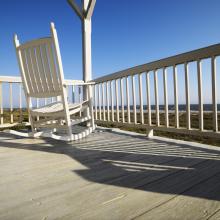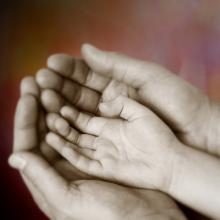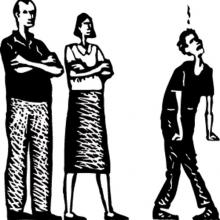Youth
Two years ago, I spoke to one young woman with obsessive-compulsive disorder as part of my research into discipleship and depression. After this woman had received her diagnosis, some well-meaning but ill-informed members of her church instructed her to pray and read the Bible more. Because of their advice, she said, “I was always wrestling with whether it was spiritual warfare.” This spiritualization exacerbated her mental health struggles, adding on a religious component to her symptoms, including compulsive prayers and other spiritual practices to gain God’s favor and find healing. When it comes to accompanying young people through mental health challenges, I know the church can do better.

“We know that the more places where a young trans person can show up in the world as their whole self, the better,” said Hartke. “So why not make church one of those places? Can we imagine a world where the church is the most supportive place in a trans person's life, rather than the place they fear the most?”
Seita Scholars have a 30 percent graduation rate, compared with national averages of 8 percent for former foster children. Maddy Day, a former director of outreach and training for the center, remembers becoming aware of the success of the Seita Scholars program while she worked at a similar program at the University of Washington.
8-year-old activist Havana Chapman-Edwards, also known as the Tiny Diplomat, closed that day with a powerful statement on climate justice intersectionality. “I am here today because climate justice issues are not separate from other justice issues. It’s not right that wildfires, droughts and other climate disasters are being ignored. Black, indigenous, and people of color are doing the least damage to the planet but we are the ones who are paying the price first.”
We launched our organization, Neighborly Faith, when we were graduate students at Wheaton College in 2015. We were there during the saga between Wheaton College administration and Dr. Larycia Hawkins, and when Wheaton students penned an open letter in the Washington Post, condemning Liberty University President Jerry Falwell Jr.’s inflammatory remarks about Muslims after the San Bernadino shootings. We saw a growing crop of evangelical college students who wanted to love their Muslim neighbors as themselves, but who were getting little guidance on how to do so from their elders.
Juliana was in high school when she first joined Our Children’s Trust to sue the Governor of Oregon for a stable climate. During my environmental education classes, I’ve discussed the litigation to illustrate the importance of a long-term view even for an urgent planetary crisis. When my undergraduates prepare conservation workshops for local schools, they know that Juliana once sat in their places. She hopes to advocate for them in the U.S. District Courthouse in Eugene, Ore. in what may be the lawsuit of their lifetimes. And regardless of this Supreme Court’s decision, youth will gather on the courthouse steps to call for their right to a stable climate.
Carlos Velazquez, 14, who attends Howard W. Blake High School in Hillsborough County, doesn’t read or write in English. But all of his courses, including physics, math, and literature, are taught by English-speaking teachers, while only one teacher is available to help Spanish-speaking students understand their coursework.
It’s not just the Dreamers who stand to lose if there are no new legislative protections put in place: It could have hefty economic consequences for states like North Carolina. Patrick McHugh, economic analyst for the progressive research and advocacy organization North Carolina Justice Center, said the Cato Institute (a libertarian think tank) predicted that ending DACA could cost North Carolina $7.8 billion in the next decade alone.
Local sports teams can serve as a training ground for young leaders. Kaepernick, and others who have knelt, are not merely using their platform for a political message — they are trying to tell us something about who they are and what they’ve gone through to get there.

Photo via Brocreative / Shutterstock.com
DAVID KING and Margot Starbuck are nostalgic for the good ol’ days of youth sports. In Overplayed: A Parent’s Guide to Sanity in the World of Youth Sports, the authors first critique the current youth sports machine by reminiscing about an athletic utopia of the past: One where kids used water bottles for goal posts and flip-flops for bases. Back when parents weren’t paying up to $18,000 in hotel and trainer fees for elite travel teams. Back when kids loved sports.
This book intends to teach parents how to prevent burnout, overuse injury, and a misguided value system for their children. However, I read Overplayed as a young single woman learning to love sports again after suffering overuse injury and burnout right before college. I wish my parents—loving and good-intentioned as they were and are—had read this book 20 years ago.
King, athletic director at a Mennonite university, and Starbuck, a writer and a parent to three teenage athletes, believe that sports has the potential to be a powerful force in the lives of children. However, often money and myths corrupt that potential. Early on, Starbuck speaks wonders of the ways athletics teach us to know and love our physicality, explaining, “I came to know my body as good because of the opportunities I had to play sports as a girl.” But with early single-sport specialization and year-round tournament schedules, children are coming to know their bodies as injured before they can come to know their bodies as good. The authors note that in 2014, 1.35 million kids suffered sports-related injuries that landed them in the emergency room. “‘No pain no gain,’” the authors insist, “should have no place in youth sports.”

Image via iofoto / Shutterstock
Stereotypes of aging fall into four buckets. The first, the persistent image that is considered by many to be the norm, is that aging is something to be reviled and dreaded. At best, growing old is something best done out of sight and mind, ideally in a gated community and ultimately in some kind of institutional setting.
A more palatable position, the second bucket, acknowledges aging as a time of inevitable decline and detachment, but thinks this is not a bad thing. Known as “disengagement” theory by gerontologists, proponents of this bucket think of aging as a problem to be solved in order to keep elders as serene as possible as they transit the wasteland of old age.
The third bucket, activity theory, swings the pendulum to the extreme. As a result, a new generation of elders has been put on the run. To age “successfully,” one must be kept busy pursuing second or third careers, finding renewed purpose, reinventing ourselves, and otherwise proving that one can be productive and engaged to the end. An unfortunate side effect of activity theory is the adulation of youth and the legitimization of denial. Don’t like the idea of aging? Just don’t do it.
But there’s a fourth bucket, the one we have been exploring together since that memorable conversation on the stairwell. That is, aging as a spiritual path. In this vision of aging, growing older takes on added meaning as a life stage with value and purpose of its own. The key is embracing rather than rejecting or denying the shadow side of aging.
The Forgiveness
By Steven
I forgive my dad for walking out on his only son
I forgive the people who think they get over
When they assume that I’m dumb
I forgive life for dealing me this hand
I forgive my inner boy for not becoming a man
I forgive the man who bumped me
Because he couldn’t see
I forgive ...
But I can’t forgive everything
Because I’ve yet to forgive me ...
Steven is an active member of the Free Minds Book Club.
Bio: Jimmie Briggs is an award-winning journalist and author of Innocents Lost, a book giving voice to child soldiers. In 2009, he co-founded the Man Up Campaign, a global effort to engage youth to stop violence against women and girls, and currently serves as executive director of the U.S. branch of Leave Out Violence (LOVE).
1. Let’s talk about LOVE. What issues does your organization address? LOVE’s focus is to engage young people who have been affected by violence of all kinds. This includes not only gender-based violence, but also issues such as gun violence, witnesses of domestic violence, and trauma- processing in schools where violence is the reality. LOVE uses media arts coupled with a trauma-informed response. We have a social worker for one-on-one counseling, and our teaching artists use media arts to provide pathways for young people who have been affected by violence—survivors and witnesses, even perpetrators—to express their voice and ultimately to process their pain, their trauma, and sometimes their guilt from the violence.
At the same time, LOVE creates a stage for them to speak about their experiences and advocate among their peers about conflict resolution and violence prevention. The arts offer a way to heal and process the violence you’ve experienced, but also for you to reach your peers and mitigate violence from happening in your schools, your home, and in your communities.
Memories of Boko Haram’s murderous spree in his Nigerian hometown haunt Tom Gowon, 9, as he sits on a patch of grass at a refugee camp, sipping steaming porridge from a plastic mug.
“I was lucky because I was not killed,” said Gowon, recalling the assault on Baga, Nigeria, in early January.
“But they shot and killed my father. My mother was kidnapped by the militants.”
Children such as Gowon bear the brunt of Boko Haram’s rampage since its fighters kidnapped more than 200 schoolgirls last year and conquered enough territory to declare a caliphate that covers one-fifth of Nigeria.
Where the militants have met resistance, they’ve torched villages and left piles of corpses in their wake.
“There are several camps around here housing many children who have lost their parents in attacks,” said Guy Nanhousngue, a Chadian relief worker who said children make up about half of the Nigerians coming to the Baga Sola refugee camp on the shores of Lake Chad, which separates the two countries.
“We’re registering more than 50 children every day.”
RURAL COMMUNITIES in the U.S. wrestle with many of the same problems facing the rest of the country—persistent unemployment, access to quality health care, air and water degradation, a broken immigration policy. Other issues—such as supporting sustainable farming practices and drawing young people into agriculture, lack of broadband access, and the challenges of small-town economic development—are more unique to rural life.
Even though the 46.2 million people living in rural U.S. counties constitute only 15 percent of the country’s total population (spread across 72 percent of the nation’s land area), we are all connected—urban, suburban, and rural—by foodways, waterways, wilderness areas, and our national politics. As one Midwest-based organizer put it, “many progressives fundamentally don’t understand rural America—they don’t even know why they should care about it. You can’t understand the power of the tea party without understanding rural America. It is the key to the House of Representatives, and progressives will be hamstrung until they can make inroads in a few key congressional districts.”
But that organizer and others also draw power and hope from the deep history of populism in the rural Midwest and parts of the South, and the endurance of community-oriented values that aren’t just “heartland” clichés.
While many young people are itching to leave rural areas and small towns—anxious to find better jobs, educational opportunities, or city culture—others have always stayed put or returned after time away. And some “city cousins” move to rural America, enjoying the opportunity to work on issues they care about (with the bonus of a brilliant night sky). Here are four stories of young people investing in rural communities in the Midwest. —The Editors
“It makes a difference in the lives of people.”
Rae O’Leary, 29, is a respiratory therapist and nurse on the Cheyenne River Indian Reservation in north-central South Dakota. The reservation straddles two counties, the fourth- and 11th-poorest in the nation. O’Leary works for Missouri Breaks Industries Research Inc. in Eagle Butte, the reservation’s hub with a population of about 1,300. She lives 20 miles out, on a ranch with her husband and two young children. O’Leary is a member of the Turtle Mountain band of Chippewa; her husband is a member of the Cheyenne River Sioux Tribe, and their children are enrolled in that tribe.
“When I define how rural we are, I tell people our nearest Wal-Mart is two hours away. That’s my point of reference for city folk.
Bio: Tyrone Parker is the executive director of Alliance of Concerned Men (ACM), a nonprofit that works with youth living in high-crime areas in Washington, D.C.
1. What event or episode in your life has most informed your passion for working with urban youth and families?
One was the loss of my son, Rodney [who was killed in 1989]. The other was the record number of homicides within the District of Columbia. The District was once considered the “murder capital” of the United States.
When we first got started with the intervention program, it was due to a 12-year-old kid who was shot in the nation’s capital on the day of the Clinton inauguration. If you would’ve gone 10 minutes on East Capitol Street, you would’ve seen the inauguration with a major celebration. And 10 minutes down the same street, you had a whole community under house arrest. After that, we came together as a group to form the Alliance of Concerned Men.
2. What sorts of services and programs does ACM provide?
We teach a number of skills to at-risk youth, including gang intervention/prevention and mediation, workforce development, life skills training, leadership development, coaching for re-entry, and youth gang conflict resolution.
CAN YOU GO to school to become an interfaith leader? An increasing number of faculty, staff, and students on campuses believe the answer is “yes.”
Interfaith leadership courses are starting to crop up at colleges across the country. At New York University and Nazareth College, you can even get a minor in the area. The organization I lead, Interfaith Youth Core, recently organized a conference for university faculty interested in this area. We expected 30 people to show up, and got nearly 120. This all suggests that this may be a field whose time has come.
Academically speaking, “interfaith leadership” is part of the larger field of “interfaith studies.” Just as you might study education at a university to become a teacher, in the future you will be able to take coursework in interfaith studies in preparation for a career in interfaith leadership.
Interfaith studies looks at the myriad ways that people who orient around religion differently interact with one another and considers the implications of that interaction for everything from personal lives to global politics. It’s a field that asks questions such as: In what religious groups is the intermarriage rate growing fastest, and what are the distinctive dynamics of such relationships? What types of political arrangements seem to foster positive interaction between faith communities, and what types are associated with interreligious tension? How effective are current religious education programs in forming young people in faith traditions?
Editor's Note: The following is an excerpt from Joy Carroll Wallis' chapter of the book Faith Forward: A Dialogue on Children, Youth and a New Kind of Christianity.
“Offering your child to God is a way of offering yourself to God again, and it felt that way to me. For the religious and not, there is a powerful spirituality in the birth of a child. Already, we’re learning a little about the unconditional love of God for us in the way we feel about our own child. Through one of the most universal human experiences, parent after parent is taught the lessons of love and life. And all is grace.” – Jim Wallis, following the birth of his son, Luke
Jim and I grew up in Christian families, which brought with it both advantages and disadvantages. My father was a clergyman in the Church of England in the inner city of South London. Jim’s parents were the founders and leaders of a Plymouth Brethren congregation in Detroit. We both rebelled and returned and our stories are well documented in the books we have written.
One of the best gifts that we experienced as the children of Christian leaders was that of an open home. Exposure to family, and friends from many different cultures and walks of life helped shape us. But, more importantly, it allowed us to grow up participating in the ministry of hospitality – and that has stuck. The Wallis home is known to be an “open house.” Our guest room belongs to many people: from a professor teaching a course in town, to a church leader participating in a fellowship program or conference; from a patient recovering from major surgery or illness, to a summer intern visiting from a far-flung part of the world. To add to this, the basement and boys’ rooms are often filled with teenagers or most of a baseball team, and our dining table is full to capacity on a regular basis.
One day when just the members of our family were sitting down to eat dinner, Jim asked who would like to say grace. Jack, who was about four at the time, looked around and said, “But we don’t have enough people!”
The Archdiocese of St. Louis is putting an end to alcohol sales at youth-related events.
Under a new policy that goes into effect Friday, drinking will not be allowed at any event that is directed primarily toward minors.
That means parents will no longer be allowed to throw back a few beers during their kids’ soccer, volleyball, and softball games. And athletic associations will no longer rake in revenue from beer sales at their concession stands.
Within the evangelical Christian universe, few things are more damning than being labeled 'Legalistic.' The term evokes images of strict rules, ruthlessness, enforced doctrines, unforgiving judges, and worst of all —unpopularity.
When churches, schools, pastors, institutions, and communities are viewed as legalistic, they are demonized and shunned — sometimes rightfully so.
One disturbing trend I’ve noticed — especially among young believers — is to assume that everything associated with a few of legalism’s attributes: structure, requirements, consequences, and work, is legalistic — it’s not.














